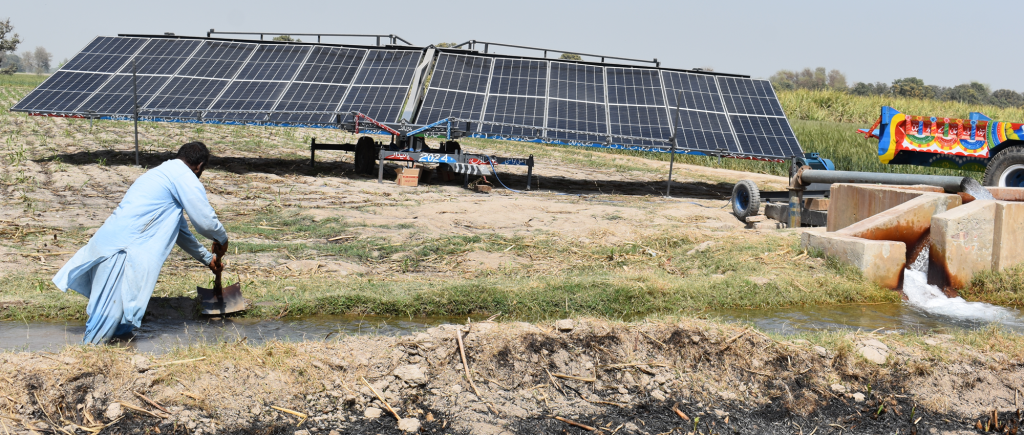Karamat Ali, a 61-year-old rice farmer from Punjab, once relied on cows and buffalos to provide his multi-generational family with milk and small earnings. Earlier this year, however, he made a decision that reflects the transformation sweeping rural Pakistan. Ali sold a dozen of his cattle and invested the money in solar panels. Those panels now power his tube well, a water well fitted with a motorized pump, allowing him to irrigate his rice fields without the burden of expensive diesel or the unreliable electricity grid. With pride, he explained that the water supply to his paddy fields is now smoother than ever before.
Across Punjab, thousands of farmers are following Ali’s example. The rise in energy tariffs in 2023, coupled with falling global prices of solar technology, has triggered a quiet revolution in the countryside. Where diesel engines and grid connections once dictated irrigation cycles, the sun now provides the power for farming. Analysts say this shift is so significant that agriculture’s reliance on grid electricity is expected to fall by 45 percent by 2025.
The Scale of Solarisation
Pakistan’s agricultural sector is undergoing one of the fastest transitions to solar energy in the region. Energy experts estimate that more than 400,000 tube wells once dependent on the national grid have already shifted to solar. Farmers have also installed an additional 250,000 solar-powered tube wells in just two years, taking the total to roughly 650,000. This surge has been made possible by China’s mass production of solar panels, which has slashed costs globally by nearly 80 percent since 2017. For farmers struggling with poverty and rising input prices, solar energy has become not just an alternative, but a necessity.
Changing Crops and Irrigation
The spread of solar irrigation has altered farming practices in profound ways. With diesel costs and power shortages no longer limiting water use, farmers now irrigate their fields several times a day in a practice known as pulse irrigation. This frequent watering, impossible in the past, has made rice a far more attractive crop. Between 2023 and 2025, rice cultivation in Pakistan expanded by almost 30 percent, while maize, a crop requiring less water, declined by 10 percent. The economic logic is simple: rice yields higher market returns, and solar makes water virtually free after the initial investment.
The Shrinking Water Table
While solar has brought relief to farmers, it has also raised fears of over-extraction of groundwater. Previously unpublished data from Punjab’s irrigation department shows that water levels have been falling at an alarming rate. By 2024, groundwater had dropped below 60 feet across 6.6 percent of Punjab, a level considered critical. Between 2020 and 2024, the share of such areas rose by 25 percent, while pockets where water levels fell deeper than 80 feet more than doubled.
Officials are divided on the cause. Federal Energy Minister Awais Leghari insists that solar pumps are not depleting groundwater, arguing that farmers are simply replacing diesel with solar without increasing cultivation. Yet interviews with farmers reveal otherwise. Many openly admit they are irrigating more frequently and expanding rice acreage, which suggests that solar is indeed intensifying pressure on Punjab’s aquifers. Provincial Irrigation Minister Muhammad Kazim Pirzada acknowledged the double-edged nature of the solar boom, describing solarisation as environmentally clean but also damaging to water reserves.
Farmers Reap the Benefits
For individual farmers, however, the economic benefits remain undeniable. In Muridke, 65-year-old Mohammad Naseem says that since installing solar panels four years ago, he has saved nearly two million rupees in energy costs. His rice yields have grown by several hundred kilograms each year, and the improved quality of his harvest has fetched better prices in the market. So valuable are his panels that Naseem dismantles them every evening and takes them home to prevent theft. Another farmer, Rai Abdul Ghafoor, is saving to purchase panels of his own, declaring that solar should be installed at all costs.
In many villages, farmers unable to afford panels on their own have pooled resources, treating them as communal assets. Families share or rent panels just as they once did with tractors. Some even sell land or jewellery to finance the purchase, knowing that the investment pays for itself in a matter of months.
Water Security and National Concerns
The debate over solar irrigation is also tied to national security. Pakistan is among the most water-stressed nations in the world and has long depended on the Indus River system, which is shared with India. When India suspended its participation in the water-sharing accord earlier this year, Punjab accelerated projects aimed at replenishing aquifers and reviving old irrigation infrastructure. Pilot programs for aquifer recharge are underway at more than forty sites, and colonial-era systems like the Ravi Siphon are being rehabilitated to stabilize river flows.
Yet experts argue that such measures remain insufficient. Environmental scientist Imran Saqib Khalid warns that Pakistan has no comprehensive mapping of wells or real-time monitoring of water withdrawals, meaning the state has little control over how much groundwater is being extracted. Without stronger governance, he argues, solarisation could ultimately weaken Pakistan’s food security by forcing future generations to abandon water-intensive crops.
A Double-Edged Revolution
The rise of solar irrigation has transformed Punjab’s agriculture into a cleaner, cheaper, and more productive system. Farmers who once struggled with rising energy prices now irrigate at will, boosting yields and securing higher incomes. At the same time, however, the unchecked spread of solar tube wells risks accelerating groundwater depletion in South Asia’s most important breadbasket.
For now, farmers celebrate their new freedom from diesel and unreliable power. But unless Pakistan develops stronger policies to regulate water use, the solar boom may sow the seeds of a deeper crisis for the country’s future food security.


